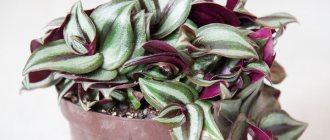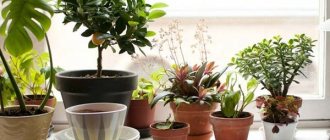In many countries, mimosa blossoms are associated with the arrival of spring. In some countries, holidays and festivals are held in honor of this flower. For most, mimosa is twigs strewn with small yellow balls of delicate flowers with a delicate aroma. In fact, the mimosa plant or silver acacia is a shrub brought to Europe from Australia.
There are certain places where mimosa grows in Russia. Acacia grows on the Black Sea coast. It can be seen in parks in the Caucasus, Abkhazia and Sochi, where it is quite hot in summer. Previously, the plant was considered rare; now it is grown by amateurs and professionals. Its cultivation is possible only in warm regions; in the northern regions it is available only in the form of bouquets.
The mimosa flower is a tropical plant that is widely grown in Brazil, where it is called "impatiens". It is a perennial plant, but it is grown as an annual plant, since the shrub loses its decorative qualities in the second year of life.
People suffering from allergies should pay attention that during flowering the plant releases a large amount of pollen, and the flowers fall off during this period.
Description of the species
Mimosa pudica at home is an annual, beautifully flowering herbaceous shrub. This is an evergreen plant 30-40 cm high. The stems are branched and very light. They are covered with spines that resemble thin hairs. The numerous leaflets of light green, double-pinnate leaves are always curled and drooped at night, and during the day - only when exposed to pressure. After a certain time, in a state of rest, the leaves unfold.
Mimosa pudica is a tender plant. The flowers are pink or lilac. They are collected in small fluffy spherical heads. They bloom for 2-3 days and fall off. The fruits are formed on the ovaries during self-pollination of the plant and have the appearance of beans. They are not eaten; their poison can cause poisoning. The flowering period is long: it begins in summer and ends in autumn. Mimosa is sometimes confused with silver acacia, which is a member of the Mimosa family but is not a plant of that name. The main difference is that its flowers are yellow.
Types of mimosa
Three types of shrubs are grown at home:
- Mimosa is bashful. It is an evergreen shrub or subshrub that grows in tropical forests. The plant is distinguished by long straight shoots. The height of the bush is one meter. The trunk is slightly pubescent and has small spines. This variety begins to bloom in summer. The flowers are small in size and have a purple-pink color.
- Mimosa rough. This species grows in the tropical rainforests of South America. The height of the tree is more than 20 meters. This mimosa blooms with white flowers, which are collected in panicle inflorescences.
- Mimosa is lazy. Decorative, very beautiful plant. The stems are branched or straight, reaching a length of 50 centimeters. The shrub has the most sensitive leaves. Lazy mimosa blooms with white flowers collected in ball inflorescences.
Growing
Mimosa pudica prefers well-lit places at home. She does not like wind, drafts and foreign odors, especially tobacco smoke. In a smoky room, its leaves curl and fall off. The best temperature for it in the summer is considered to be 20-25 degrees, and in winter 16 is enough. The shrub loves moisture, but in moderation. In spring and summer, it needs to be watered regularly and abundantly; in extreme heat, sprinkling should be done. And in winter, when the plant is resting, it is enough to monitor the condition of the soil and prevent it from drying out. Water as needed. Overmoistening can lead to loss of decorativeness. Mimosa pudica grows better on loose, fertilized soil. Growing from seeds makes it possible to obtain many shrubs at the same time.
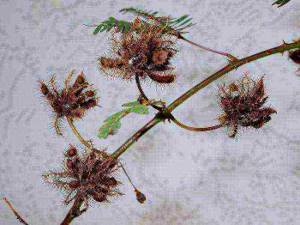
For fruit to set, the plant must be pollinated. You can carry out this process yourself. It is enough to transfer the pollen with a brush or soft swab. After this, a pod begins to form. When it is ripe and dry, it is picked and placed in a paper bag. The pod will be stored in it all winter, until spring. It is important to remember that this plant is difficult to preserve in winter; it dies.
Mimosa pudica: features of care at home
Yellow mimosa is a stylish and beautiful element of indoor interior design. Caring for such a house plant is absolutely easy. Standard care consists of the correct choice of planting container and nutritious soil substrate, as well as timely watering and fertilizing, protection from diseases and pests.
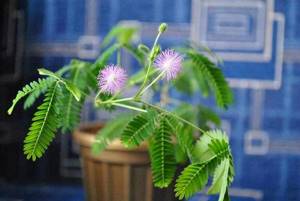
Content requirements
Mimosa pudica loves a sufficient amount of light and easily tolerates even direct sunlight. In temperate climatic conditions, a southern exposure is optimal for such a crop, and in regions with a hot, sunny climate, the plant is best located in the southeastern part. You can also install a flower pot with a plant on the windows of the western or eastern direction. When placing mimosa on southern windows on especially hot days, it is recommended to shade the above-ground part of the crop during the midday hours, which will prevent the formation of burns on the foliage.
During the period from March to October, active growth processes and flowering are observed, so the optimal comfortable temperature for the plant will be 20-24°C. In winter, the temperature should be reduced to 16-18°C. Decorative crops need sufficient moisture. It is best to use drainage trays filled with damp pebbles or moistened sphagnum moss under flower pots.
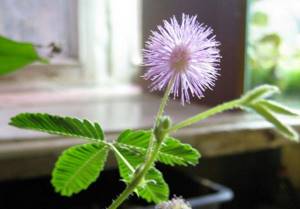
Planting soil and pot
For planting and replanting indoor crops, you can use almost any ready-made nutrient soil that is suitable for growing beautiful flowering and ornamental plants. The main condition is sufficient looseness and nutritional value of such a soil substrate.
If necessary, you can make the planting mixture yourself. For this purpose, one part of peat, two parts of clay-turf soil, one part of deciduous soil and ½ part of coarse-grained clean sand are used. For homemade soil, you can also use one part of greenhouse soil, one part of peat soil, one part of rotted manure and one part of coarse clean sand or perlite.
The flower pot should not be too wide or high, and its volume should correspond as much as possible to the size of the root system of the ornamental indoor plant being planted or replanted. The planting container must have high-quality drainage holes to prevent stagnation of moisture in the soil and rotting of the root system.
Growing mimosa from seeds (video)
Watering and fertilizing
Irrigation measures and well-chosen fertilizing are very important at different stages of growth and development of such a tropical plant. Irrigation activities must be intensive. For irrigation, only well-heated water at room temperature is used. Watering is carried out every three days. Watering by immersing the flower pot in water has proven to work best. The soil mixture should be constantly moist, but not waterlogged.
Even a slight lack of moisture can cause massive leaf loss. It should be remembered that when watering, it is necessary to completely prevent water from getting on the foliage. Decorative crops need to be fed from spring to mid-autumn, about a couple of times a month. Liquid fertilizers are used for feeding, but organic fertilizers also give good results.
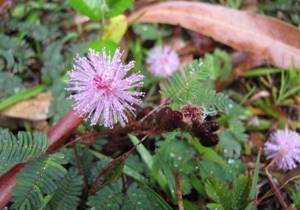
Diseases and pests
If the cultivation regime is not followed, the plant may be affected by diseases and pests:
- in the absence of regular irrigation measures and a decrease in air humidity in the room, leaf shedding is often observed;
- yellowing and non-opening of plant leaves may be the result of significant waterlogging of the soil;
- strong elongation of the above-ground part very often results from insufficient lighting;
- lack of flowering is observed in insufficient lighting, as well as low temperature conditions.
The main pests of indoor crops are most often plant aphids and spider mites, the destruction of which is carried out with special chemicals.
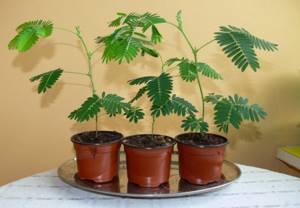
Transplantation and propagation
Only young and actively growing plants need to be replanted. Propagation of the crop is carried out by seed. Seeds pre-soaked for a couple of days should be sown in a nutrient mixture based on peat and perlite.
The surface of the soil substrate must be moistened abundantly, after which furrows are made and seeds are sown with a depth of 10 mm and a distance of 50-60 mm from each other. The container with sowing must be covered with polyethylene and placed in a warm place with direct sunlight or using fluorescent lamps.
Mass shoots appear in a couple of weeks. The first fertilizing is carried out a couple of weeks after germination , with a solution of standard complex fertilizer. If necessary, seedlings are thinned out and planted in separate flower pots.
Transfer
Mimosa pudica grows at home as an annual; there is no need to replant it. If necessary, this is done in the following cases:
- When the bush is left for the winter and grown as a perennial plant.
- If the “touch-me-not” gets sick or the soil begins to rot.

Transplantation should be done using the transshipment method. The plant is placed in a larger pot along with a lump of earth. First, the bottom of the pot is covered with pebbles, which will serve as drainage. The soil is prepared in advance. The earth is mixed with sand, peat and rotted leaves. It is better to replant shrubs early in the morning or in the evening, when the sun has set.
Reproduction
Mimosa pudica can easily grow from seeds, but they should be planted only in March and April. Their shape resembles beans or peas squeezed from the sides, the peel of which is very dense and has a glossy shine. To germinate, you need to take a pan, pour soil into it and lay out the seeds without covering it with soil. You can press down a little for better contact with the soil. Then the future shy mimosa is poured with hot water. The seeds will begin to crack, this is normal. Cover the top of the pan with a lid. This will maintain the required humidity. After some time, the beans will sprout. The bashful mimosa will give forth friendly sprouts. Growing from seeds is a hassle, but it's worth it.
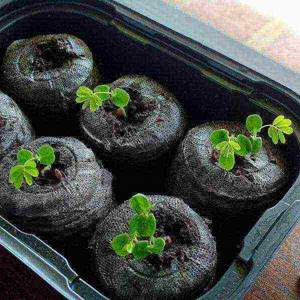
Sprouted beans are planted in well-loose soil. Within a week, shoots will appear. When they grow to the size of several leaves, they can be transplanted into separate pots with good drainage and sterile soil. To destroy bacteria, it is enough to spill it with a solution of potassium permanganate.
How to grow mimosa pudica (video)
Representatives of the species can be shrubs or subshrubs, the above-ground part of which reaches a height of a meter. Straight shoots have characteristic pubescence and are covered with relatively long spines. The foliage is small, numerous, has a pinnate oblong-lanceolate shape, and has pubescence. The flowers of the bashful mimosa are formed from the axillary part of the apical shoots. The flowers are collected in capitate inflorescences, which have an attractive purple-pink color. Flowering occurs between June and August. In indoor floriculture, this species is most often grown as an annual.
When and what to feed mimosa?
Touch-me-not, like any plant, needs nutrients. She receives them during feeding. It is carried out when the bush is actively growing. In spring and until mid-summer, indoor mimosa bashful is fed with nitrogen, potassium and phosphorus. These fertilizers are mixed in equal proportions and applied to the soil twice a month. In the second half of summer and until the beginning of autumn, buds form. Therefore, phosphorus and potassium are needed in large quantities. To make the soil more nutritious, bone meal should be added to it. You can fertilize with complex mixtures for home flowers. In autumn, shoot growth stops. At this time, the application of any fertilizers stops. If this is not done, the mimosa pudica will not rest and may weaken. Growing a houseplant will not bring pleasure, as the bush will lose its decorative effect.
Beneficial features

Touch-me-not is known for its beneficial properties. It has long been used in medicine in many European countries. Non-traditional methods of treatment are not complete without the use of the healing properties of this plant.
- Tincture from the leaves treats sore throat and reduces fever.
- A decoction of the bark - dysentery and headache.
- Ointments treat burns and heal wounds.
- Mimosa preparations purify the blood.
- Helps in treating the heart and nervous system.
- The liver and gallbladder are tidied up.
What causes illness and damage to mimosa?
- If the bush experiences excess moisture, its leaves will turn yellow and begin to curl during the day.
- When a plant grows in a room where tobacco smoke is always present, it sheds its leaves.
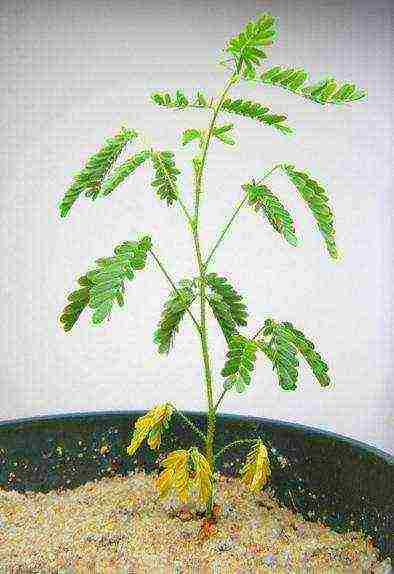
- Leaf falling is also associated with irregular watering.
- With a lack of lighting and low air temperatures, mimosa bashful feels uncomfortable. Flowers will never appear under such conditions.
- If the “touch-me-not” grows slowly and does not bloom, you need to pay attention to the soil: it is obviously depleted. In this case, you urgently need to feed the plant and create the necessary conditions for growth.
- If mimosa bashful is infected with spider mites at home, its leaves begin to turn pale. After a while they turn yellow and dry out. Numerous green or yellow dots and cobwebs appear on them. This means that the room is too dry and the air is hot.
- At the first sign of aphid infestation, the leaves of the plant curl and turn yellow. Small black or green bugs appear on the shoots. This is the aphid. It feeds on cell sap and inhibits growth.
To combat pests, they need to be collected manually, and then washed off with soapy water or wiped on both sides of the leaves. In case of severe damage, spraying with chemicals is used. The most important thing is that in order for the plant to be comfortable in your home, you need to create favorable conditions for its growth. Then many negative consequences can be avoided.
Growing and care
How to grow mimosa pudica at home?
Reproduction
At home or in greenhouses, mimosa pudica is grown as a houseplant from seeds.
The easiest way is to buy a mimosa pudica flower.
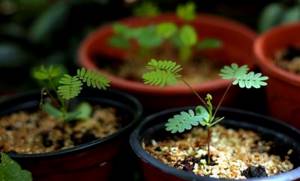
There are three breeding options:
- Option 1 – planting by cuttings,
- Option 2 – planting from seeds,
- Option 3 – growing by pollinating an adult plant.
Cuttings
The method of growing mimosa from cuttings is ineffective, so rarely anyone uses it.
Seeds
How to plant mimosa pudica from seeds?
At home, it is more convenient to grow the plant from ready-made seeds, which are sold in flower shops. The technology is simple.
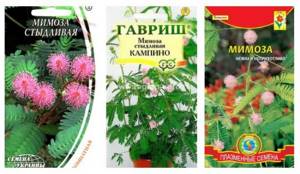
It is better to plant the finished seeds in late February - early March in moist soil. Recommended deadlines are by early April.
The composition of the soil for mimosa pudica should be as follows:
- turf,
- leafy,
- peat land and
- sand.
Everything is taken in the ratio 1:1:1:1.
You can also purchase ready-made soil suitable for this type of plant.
Expanded clay is suitable as drainage.
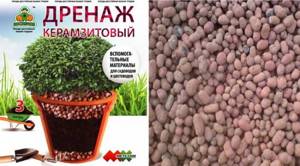
After planting, cover the container with film, a bag or glass, and place it in a warm place, away from direct sunlight.
Before germination, it is necessary to periodically remove the film and ventilate the container. Seeds germinate quickly, within 25-30 days.
Sprouts, 4-5 cm long, are transplanted into pots and placed in a well-lit place. After the plants get used to sunlight, they can be moved to the windowsill.
Collecting seeds
How to grow mimosa pudica from an adult plant?
If you already have mimosa in the house, then to grow it you need to follow these simple steps.
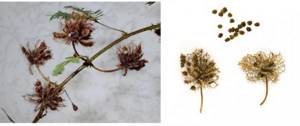
- To pollinate an adult plant - use a brush to transfer pollen from one flower to another. Wait for the fruit to appear.
- Once dry, collect the pods. Store them in a paper bag in the refrigerator.
- At the end of February - beginning of March - the time for planting - remove the seeds from the pods, pour them with warm water for 25-35 minutes.
- Prepare containers for planting - lay out drainage, fill with moist soil.
- Plant the seeds to a depth of 1 cm, cover with a bag, glass or film. Place in a shady place.
It is important to avoid direct sunlight!
If the air temperature is kept from 20 to 25C, the first sprouts will appear in a couple of weeks or, at the latest, in a month.
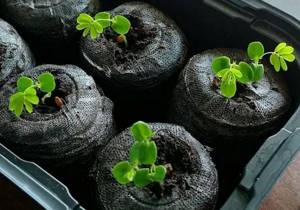
Transplant sprouts 4-5 cm long into separate glasses (plastic ones are suitable) and place them in a warm place.
At the end of May - beginning of June, transplant the grown sprouts into pots.
Some gardeners advise planting several sprouts in one pot.
Transplanting mimosa pudica
Mimosa pudica is considered an annual plant and replanting is usually not necessary.
But, in rare cases, if its branches persist in winter, the plant should be transplanted into a larger pot.
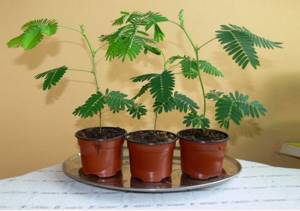
This must be done very carefully. Without disturbing the earthen lump, drag the flower with it in a smooth movement into another pot, having previously prepared and moistened the soil in it. After transplanting, care for mimosa as before.
Creating favorable conditions
Mimosa pudica is easy to care for. Despite its tenderness and vulnerability, with proper care, mimosa grows actively from April to October.
Blooms for about 4 months. Dies in winter.
Temperature
The plant loves warmth, but cannot tolerate scorching heat. An adult plant loves the sun and bright rays. But it is better for young sprouts to avoid them so as not to get burned.
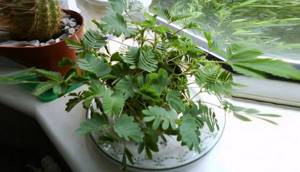
The ideal air temperature should be between 20-25C. In winter, a drop in temperature to 18-20 C is acceptable.
Watering
In spring and summer, water abundantly and regularly - in the morning, every other day. It is advisable to water with soft water; distilled water is also suitable.
If the plant's leaves turn yellow, it means there is not enough water or the place where it is located is not sufficiently illuminated by sunlight.
In winter, you can keep the soil moist.
Fertilizer
Like many other plants of this species, mimosa pudica needs additional fertilizer during the growing season.
It is enough to apply fertilizer 2 times a month.
Diseases and pests
If you keep it carefully, you won’t have to worry about aphids and spider mites – the main pests of mimosa.
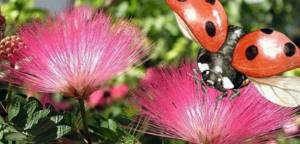
If infection occurs, the leaves begin to turn pale, then turn yellow and fall off.
When infested with aphids, the leaves quickly curl and fall off, and small bugs appear on the stems.
Pests are collected by hand, taking care not to damage the stems and leaves of the mimosa. Wipe the plant itself with soapy water.
If the infection is severe, then it is necessary to use chemicals.
Interesting Facts
The Mimosa pudica plant reacts very quickly to any touch or mechanical vibrations. As a result of experiments, it was revealed that the plant remembers stimuli and somehow adapts to them. If you drip water onto the mimosa with equal frequency, it will stop curling. After some time, we will again influence the plant in a similar way. The result will exceed all expectations: the “touchy one” will behave completely calmly.
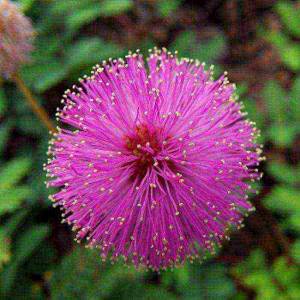
An interesting fact is that the mimosa festival is held in France. This holiday was first held in the province of Pierre-Riche at the beginning of the twentieth century. Currently, it has not lost its significance. Numerous hills are covered with mimosa thickets. Thousands of flowers emit a pleasant, rich aroma. The blooming of mimosa in France means the end of winter and the beginning of spring. In honor of the flower festival, parades are held throughout the country.
Publication date: Cultivation






